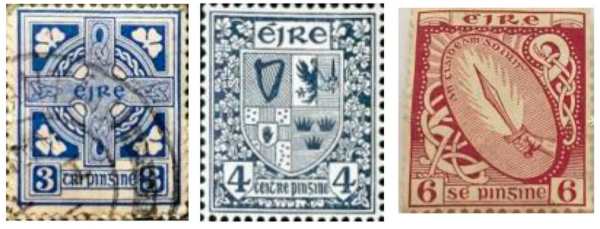
The formation of the Irish State (the 'Free State') in 1922 landed the new Irish Government with a sudden abundance of practical issues to solve. Apart from the fact that a Civil War was about to break out there was also the not inconsequential issue about how the new Ireland should announce its arrival to the world.
One of the ways this is most obviously achieved is by the creation of new coinage and stamps.
As an interim measure the existing stock of British stamps were still used in Ireland, and were over-printed with 'SaorstŠt …ireann' on them. Clearly this was not a situation that could continue!
So, in early 1922 the newly appointed Irish Postmaster General J.J. Walsh, announced that there would be an artistic competition so that new Irish stamps could be created. It was required that the submitted designs must be
'symbolical in character, and the inscriptions must be in Gaelic characters'.
The competition attracted great interest from artists including Harry Clarke and Wilhelmina Geddes, both of whom were also well known for their beautiful work with stained glass. Over 800 entries were received.
The design by James Ingram was the first to be printed onto an Irish stamp and is perhaps
the most iconic Irish stamp every created. The design featured an outline map of Ireland with an arch and zoomorphic ornamentation with shamrocks and Gaelic words.
It is important to note that the entirety of Ireland was shown in the artwork with no visible indication of a border around the six Counties in Ulster. Yet the design is technically accurate as the stamp was issued a matter of days before 'Northern Ireland' actually 'opted out' of the new Irish State in December 1922 as per the terms of the hotly disputed Anglo-Irish Treaty.

It was the following year, 1923, that the other 3 stamps in this most famous set of Irish stamps were issued. Lily Williams, Millicent Grace Girling and John J O'Reilly designed the famous blue Celtic Cross stamp, the Four Provinces of Ireland stamp, and the famous
'An Claidheamh Soluis' stamp (meaning 'the sword of light').
The design of these stamps was intended to indicate the Irish State as being one based in its own exclusive history and culture, with the extensive use of Irish symbols and language. An expression of nationalism. Yet it is remarkable how these intricate designs are similar in tone to earlier stamps issued by Irish nationalists.
In 1865 the Irish Fenians in north America instigated a number of raids against British forces in what would soon become Canada. They hoped that the agitation in America would inspire agitation in Ireland. As part of their propaganda they created and printed several stamp designs in Boston, a number of which were distributed, raising funds but ultimately having only symbolic value.
Yet it is this very symbolism that endured. Some examples of these Fenian stamps below (known as 'forerunners' and sold for 1, 3 and 24 US cents), would surely not look out of place among those stamps that were actually issued in Ireland over a half a century later.

Apart from stamps there were other efforts to indicate that Ireland was a new nation state.
Irish Passports were introduced in 1923,
Coins in 1928 and the imperial red post boxes were gradually painted green! (covering up the original red).
The first Irish
commemorative stamp (as opposed to a
definitive stamp) was of
Daniel O'Connell in 1929. We have no way of knowing what the man known as
'The Liberator' would have thought about Ireland's progress. But what is certain is that the implementation of these seemingly innocuous symbols greatly helped to cement the place of the new Irish State within the consciousness of the world.

 The formation of the Irish State (the 'Free State') in 1922 landed the new Irish Government with a sudden abundance of practical issues to solve. Apart from the fact that a Civil War was about to break out there was also the not inconsequential issue about how the new Ireland should announce its arrival to the world.
The formation of the Irish State (the 'Free State') in 1922 landed the new Irish Government with a sudden abundance of practical issues to solve. Apart from the fact that a Civil War was about to break out there was also the not inconsequential issue about how the new Ireland should announce its arrival to the world.
 It was the following year, 1923, that the other 3 stamps in this most famous set of Irish stamps were issued. Lily Williams, Millicent Grace Girling and John J O'Reilly designed the famous blue Celtic Cross stamp, the Four Provinces of Ireland stamp, and the famous 'An Claidheamh Soluis' stamp (meaning 'the sword of light').
It was the following year, 1923, that the other 3 stamps in this most famous set of Irish stamps were issued. Lily Williams, Millicent Grace Girling and John J O'Reilly designed the famous blue Celtic Cross stamp, the Four Provinces of Ireland stamp, and the famous 'An Claidheamh Soluis' stamp (meaning 'the sword of light').

